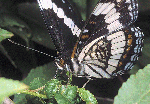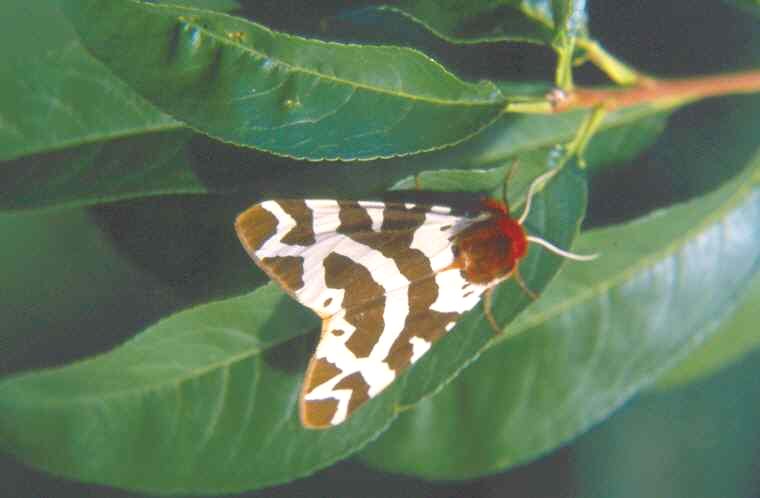|

|
Utah Lepidopterists'
Society
Founded 6 Nov 1976 |

|
Utah Lepidopterists' Society
Mission Statement
The Utah Lepidopterists' Society is a
Utah-based non-profit organization of butterfly and moth collectors
from throughout the state and beyond. The Society, now 45 members
strong, meets on the second Saturday of each month, alternating
between the Monte L. Bean Life Science Museum at Brigham Young
University and the Utah Museum of Natural History at the Univ. of
Utah--excluding summer months. Please see 2007
Meeting Schedule.
During monthly meetings, the Society
enjoys a major presentation within the scope of Lepidoptera or
related issues. Members attend meetings for many reasons. For
example, some are engaged in scientific research and are willing to
share their findings with other members of the U.L.S. through the
Society Bulletin, Utah
Lepidopterist. At the same time,
others look forward to meeting with fellow members and renewing
acquaintances or just socializing about interesting experiences that
they have with regards to the hobby. While others are new and are
eager to make new friends and learn as much as they can about
butterflies and moths or learn about places that they can go to find them. (Please see the habitat
section to learn more about where to find Utah butterflies.)
Even though the Society supports
conservation principles in the practical sense, it does encourage the
building of scientific collections. The Society also supports the
Statement on Collecting Lepidoptera as adopted by The Lepidopterists' Society
on 13 Jun 1996 in Houston, Texas. (See below.)
The Lepidopterists' Society's
Statement on Collecting Lepidoptera
adopted by the Executive Council: 13 June 1996,
Houston, Texas
The Lepidopterists' Society affirms that collecting Lepidoptera is
one of many legitimate activities enabling professional and
avocational lepidopterists to further the scientifically sound and
progressive study of Lepidoptera and education about Lepidoptera as
well as encouraging interaction between professional and avocational
lepidopterists.
The foregoing Statement of The Lepidopterists' Society is
accompanied by the following Collecting Guidelines. The Guidelines
elucidate the manner in which collecting should be conducted.
Practitioners are encouraged to adopt these Guidelines and to use the
Guidelines for the instruction of others.
Collecting Guidelines
PREAMBLE
Our responsibility to assess and preserve natural resources, for
the increase of knowledge, and for the maintenance of biological
diversity in perpetuity, requires that lepidopterists examine the
practices of collecting Lepidoptera for the purpose of governing
their own activities.
To this end, the following guidelines are outlined, based on these
premises:
- 0.1 Lepidoptera is one of the largest order of insects.
Lepidopterans are an important component of biological diversity.
- 0.2 Lepidoptera are conspicuous and scientifically well known,
thus they are frequently used as indicator groups for conservation
programs.
- 0.3 The collection of Lepidoptera
- 0.31 is a means of introducing children and adults to
awareness and study of their natural environment;
- 0.32 has an essential role in the elucidation of scientific
information, both for its own sake and as a basis from which to
develop rational means for protecting the environment, its
resources, human health, and the world food supply;
- 0.33 is an educational activity which generally can be
pursued in a manner not detrimental to the resource involved.
GUIDELINES
PURPOSES OF COLLECTING (consistent
with the above):
- 1.1 To create a reference collection for study and
appreciation.
- 1.2 To document regional diversity, frequency, and variability
of species, and as voucher material for published records.
- 1.3 To document faunal representation in environments
undergoing or threatened with alteration by humans or natural
forces.
- 1.4 To participate in development of regional checklists and
institutional reference collections.
- 1.5 To complement a planned research endeavor.
- 1.6 To aid in dissemination of educational information.
- 1.7 To augment understanding of taxonomic and ecologic
relationships for medical and economic purposes.
COLLECTING METHODS:
- 2.1 Collecting adults or immature stages should be limited to
sampling, not depleting, the population concerned. Numbers
collected should be consistent with the purposes outlined in
sections 1.1 through 1.7.
- 2.2 Where the extent and/or the fragility of the population is
unknown, caution and restraint should be exercised.
DATA SHARING:
- 3.1 All data should be recorded, and the data should be made
available to appropriate interested parties.
LIVE MATERIAL:
- 4.1 Rearing to elucidate life histories and to obtain series
of immature stages and adults is to be encouraged, provided that
collection of the rearing stock is in keeping with these
guidelines.
- 4.2 Reared material in excess of need should be released only
in the region where it originated, and in suitable habitat.
ENVIRONMENTAL:
- 5.1 Protection of the supporting habitat must be recognized as
the sine qua non of protection of a species.
- 5.2 Collecting should be performed in a manner such as to
minimize trampling or other damage to the habitat or to specific
foodplants.
- 5.3 Property rights and sensibilities of others must be
respected.
- 5.4 Collectors must comply with regulations relating to
publicly controlled areas, to individual species, and to habitats.
RESPONSIBILITY FOR COLLECTED MATERIAL:
- 6.1 All material should be preserved with all known data
attached.
- 6.2 All material should be protected from physical damage and
deterioration, e.g. light, molds, and museum pests.
- 6.3 Collections should be made available for examination by
qualified researchers.
- 6.4 Collections or specimens, and their associated written and
photographic records, should be willed or offered to the care of
an appropriate scientific institution, if the collector lacks
space or loses interest, or in anticipation of death.
- 6.5 Type specimens, especially holotype or allotype, should be
deposited in appropriate scientific institutions.
RELATED ACTIVITIES OF COLLECTORS:
- 7.1 Collecting should include permanently recorded field notes
regarding habitat, conditions, and other pertinent information.
- 7.2 Recording of observations of behavior and of biological
interactions should receive as high priority as collecting.
- 7.3 Photographic records, with full data, are to be
encouraged.
- 7.4 Education of the public regarding collecting and
conservation, as reciprocally beneficial activities, should be
undertaken whenever possible.
- 7.5 All known data should be recorded with the specimens, e.g.
date, location, collector, habitat, larval host plant data, and
parentage of immatures, when known.
TRAFFIC IN LEPIDOPTERAN SPECIMENS:
- 8.1 Collection of specimens for exchange or sale should be
performed in accordance with these guidelines.
- 8.2 Rearing of specimens for exchange or sale should be from
stock obtained in a manner consistent with these guidelines, and
so documented.
- 8.3 Mass collecting of Lepidoptera for commercial purposes and
collection of specimens for creation of saleable artifacts are not
included among the purposes of the Society.
LEGAL CONSIDERATIONS:
- 9.1 Collectors should comply with local, state or provincial,
federal and national, and international laws and regulations that
govern collecting and possession, commerce and exchange, import
and export, and protection of species. Collectors should comply
with additional local, state or provincial, federal and national,
and international laws and regulations governing live material.
COMMITTEE MEMBERS:
Dr. Vitor Becker
BRAZIL
Dr. Lincoln P. Brower
Gainesville, Florida
Dr. Charles V. Covell, Jr.
Louisville Kentucky
Dr. Thomas Emmel
Gainesville Florida
Dr. J. Donald Lafontaine
CANADA
Stephanie McKown
Camas, Washington
Eric H. Metzler, Chair
Columbus Ohio
Dr. Kauri Mikkola
FINLAND
Dr. Scott Miller
Honolulu Hawaii
Dr. Paul A. Opler
Fort Collins, Colorado
Dr. Kenelm W. Philip
Fairbanks Alaska
Dr. Jerry A. Powell
Berkeley California
Dr. Floyd and June Preston
Lawrence Kansas
Dr. Frederick W. Stehr
ex officio member
East Lansing Michigan
Dr. J. Benjamin Ziegler (dec.)
Summit New Jersey
All images of Limenitis
weidemeyeri on the ULS Info Bar courtesy Jay
Cossey
e-mail comments to the ULS
Webmaster

